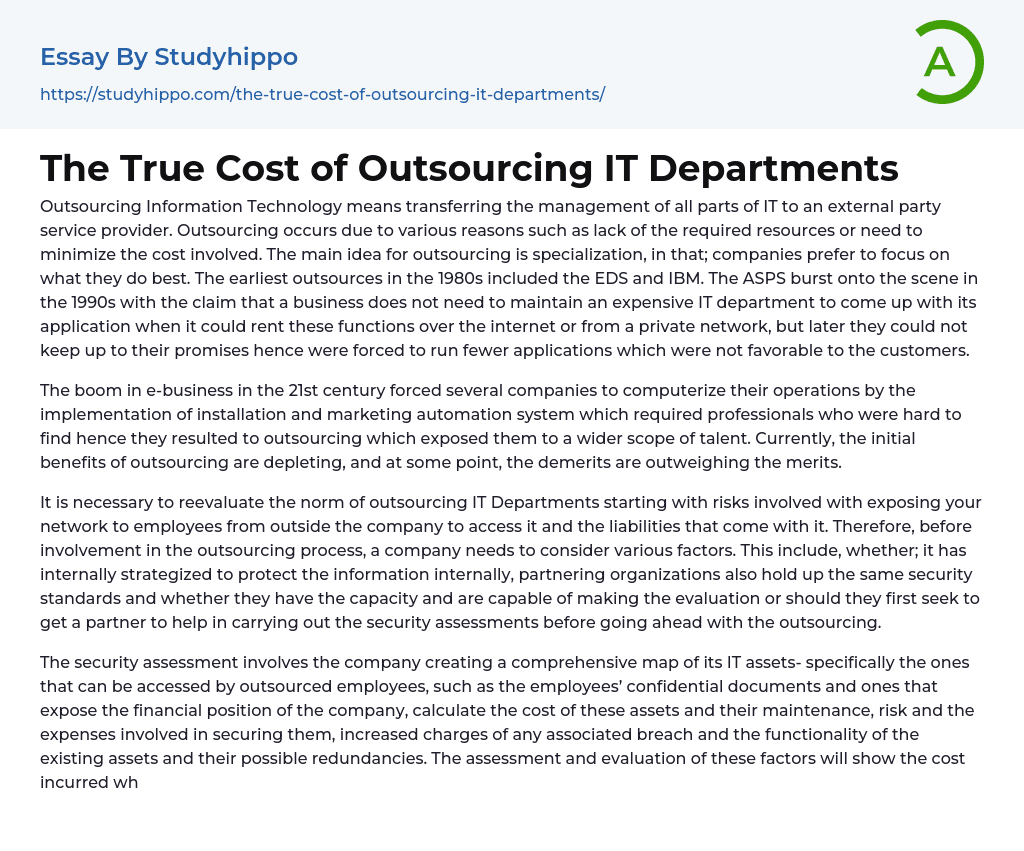

The True Cost of Outsourcing IT Departments Essay Example
Outsourcing Information Technology refers to the transfer of IT management to an external service provider. This is done for reasons like limited resources or cost reduction. The primary motive behind outsourcing is to specialize and allow companies to prioritize their core competencies.
In the 1980s, the early outsourced services included EDS and IBM. In the 1990s, the ASPS emerged and claimed that businesses could rent IT functions over the internet or from a private network, eliminating the need for expensive in-house IT departments. However, they failed to live up to their promises, resulting in fewer applications that were not favorable to customers. The rise of e-business in the 21st century led to companies computerizing their operations with installation and marketing automation systems. Finding professionals for these systems was difficult, so they turned to outsourcing, which provided access to a wider range of talent. However, the in
...itial benefits of outsourcing are now diminishing, and the disadvantages are becoming more significant.
When considering outsourcing IT departments, it is crucial to reevaluate the norms and assess the associated risks. These risks include exposing the company network to external employees and the liabilities that come with it. Prior to engaging in outsourcing, companies should consider various factors. Firstly, they need to determine if they have internal strategies in place to protect confidential information. Additionally, they should ensure that partnering organizations adhere to the same security standards. Furthermore, companies should evaluate their own capacity to conduct security assessments or seek assistance from a partner. The security assessment entails creating a comprehensive map of IT assets, including those accessible to outsourced employees. This mapping should include confidential employee documents and financial information. It
is also important to calculate the cost of maintaining these assets, identify any potential risks, evaluate expenses related to securing these assets, and consider possible redundancies in existing assets. By evaluating these factors, a company can determine the overall cost associated with outsourcing. One crucial but often overlooked factor is the evaluation of potential data breaches resulting from network exposure.
According to auditors' reports, service providers, consultants, and contractors pose a significant cyber security threat. As a result, it is crucial to thoroughly evaluate any outsourcer before entering into a contract with them. The field of Information Technology is constantly evolving, with advancements in operating systems and the introduction of new technologies. This necessitates organizations to develop strategies for adapting to these changes quickly, which can incur additional costs. Unlike dealing with internal IT sources, utilizing outsourcers means incurring extra expenses for any additional tasks or services, even if there is a fixed rate agreement in place. This is because outsourcers may need to perform duties beyond their initial job description or role specification, resulting in additional charges. Therefore, different situations require different payment models.
Outsourcing leads to additional costs due to the time required for the new source to adjust to the organization's system, unlike internal IT experts who are already familiar with it. This becomes a problem when there are new developments that the outsourcers are not knowledgeable about, as the company would need to find another outsourcer with information on this new invention. This results in paying both parties, making it more expensive compared to having a constant internal source that can handle these adjustments at the usual wage.
In conclusion, before outsourcing the IT
Department, it is essential to thoroughly evaluate the entire application portfolio, comparing the advantages of available functionality and external access with the risks and security merits. Outsourcing was once seen as a solution to staffing challenges but currently faces problems such as increased costs, security issues, prolonged project completion times, and constant updates in the field.
References
- IT Outsourcing, Business Process Outsourcing, and Knowledge Process Outsourcing in China. (2015). Source Code China, 135-155. doi:10.1002/9781119198086.ch8
- Willcocks, L., & Lacity, M. C. (2012). The new IT outsourcing landscape: From innovation to cloud services. New York: Palgrave Macmillan.
- Business Analysis essays
- Business Plan essays
- Community Development essays
- Competition essays
- Effective Leadership essays
- Leadership Styles essays
- Mission Statement essays
- Negotiation essays
- Outsourcing essays
- Planning essays
- Public relations essays
- Reasoning essays
- Strategic Management essays
- Strategic Planning essays
- Swot Analysis essays
- My Favorite Place essays
- Overcoming Obstacles essays
- Taking Risks essays



